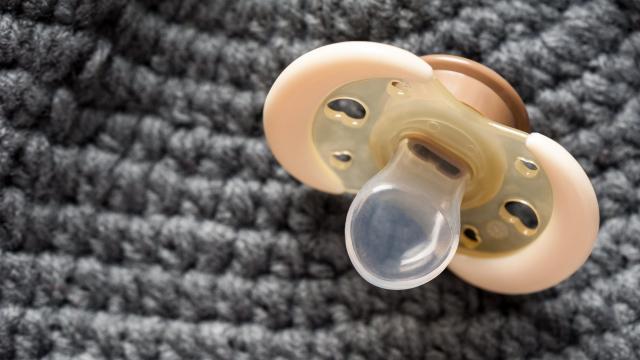The pacifier can be a wonderful thing: It can soothe a fussy baby, help them fall asleep, or offer a temporary distraction. Plus, once breastfeeding is established, the American Academy of Pediatrics says offering one at nap times and bedtime can help reduce the risk of sudden infant death syndrome (SIDS). But at some point, between ages two and four, they may need some help kicking the habit.
If you’re looking for the easiest time to wean a child from a pacifier, it’s probably earlier than you think — Dr. Harvey Karp, of The Happiest Baby on the Block, says six or seven months old is the sweet spot for many babies (by nine months old, the emotional attachment to it begins). Even if you let them hang onto their pacifiers past infancy, many toddlers will stop using them on their own. But if they’re still sucking away by about age three, the American Academy of Pediatric Dentistry says it’s time to wean them off it, before prolonged use leads to orthodontic problems.
There are a few different methods you can try — some are fasts, some are slow, and some involve magical beings. Let’s discuss.
The three-day method
This is probably the fastest way to go, and all it really requires is a few conversations with your toddler and a steely resolve. If you’re going to go this route, you need to be committed. As Marguerite Lamb writes for Parents.com:
In the morning and at bedtime, tell your child that you can see she wants to do lots of things that make her older. Tell her that’s a good idea, and that in three days it will be time for her to say goodbye to her pacifiers. Tell her you know she can do it and that you’ll work together on it. Keep the talk to 30 seconds and don’t sound as if you’re asking permission. If your child responds, reflect back her feelings — ”I know you don’t want to” — then move on. Don’t worry that your child will become anxious if given advance warning. “That’s a myth,” says [Mark] Brenner, [author of Pacifiers, Blankets, Bottles & Thumbs: What Every Parent Should Know About Stopping and Starting]. “Like adults, children like to prepare themselves physically, psychologically, and emotionally for change.”
On day two, you have the same two matter-of-fact chats about how tomorrow is the day. And then on day three, you enlist their help gathering up all their pacifiers, place them in a plastic bag, and take them outside to be “recycled” into other toys for kids. (Don’t simply throw them in the trash; it’ll take some of the sting out if they think their beloved binkies are going to do more good in the world.)
And then prepare yourself for the very real possibility of a meltdown. You can, of course, be empathetic about how they feel, but you need to stay firm, as well. Brenner says most toddlers will get over the loss of their pacifiers in about two days.
The more gradual approach
To wean a toddler from a pacifier more gradually, start to set some limits in the amount of time they’re allowed to have it and under what conditions. You might start by eliminating the use during times when they need it less, such as immediately after nap times, when they’re in the car, or when they’re playing with toys in the living room. Eventually, get to the point where they’re only allowed to have it for nap times and at bedtime, and eventually eliminate that, too.
You can also decide that as the pacifiers get lost or damaged, you simply won’t replace them. You’ll eventually go from having one in every room to just a couple, and explain that when the last one is missing or broken, that’s the end of using a pacifier.
Some experts also suggest poking a hole into the pacifier or cutting off its tip so that it loses its suction (and, therefore, its appeal). If you cut the tip off, though, proceed with caution as that could make it easier for a small piece to come loose and become a choking hazard; only let them use it when they’re being supervised.
The magical approach
We have fairies who come to take our children’s teeth away; why can’t we have fairies who take their pacifiers, too? The magical binky fairy is popular among parents of pacifier-loving toddlers, and for good reason. The binky fairy comes on a special day, which could be their birthday or another milestone day. The fairy takes their old binkies to deliver to little babies who need them (only use this part if you think it won’t create jealousy) and leaves a new “big kid toy” in its place.
You can switch up the details about the magical creature that comes for the binkies and even let the toddler choose when they’re ready for the visit.
Here’s how a parent named Emily in our Offspring Facebook group successfully handled it: “We spent several months talking about the ‘binky birdies’ who would leave a present if we gave them binkies when we were ready to give them up (for an almost-three-year-old). One Friday, he was ready and he gave up the green one, then the blue one the next day, and we’ve been enjoying the Duplo ever since!”
Whichever approach you take, consider the timing, as well. You won’t want to wean them from their pacifier if they’re going through any other kind of stressful transition, such as starting a new daycare, welcoming a baby sibling, or moving to a new home. Choose a time when they won’t need to depend on the pacifier as much for soothing.

Leave a Reply
You must be logged in to post a comment.